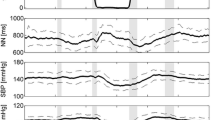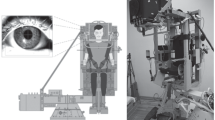Summary
The four science crewmembers of Spacelab-1 were tested for postural control before and after a 10 day mission in weightlessness. Previous reports have shown changes in astronaut postural behavior following a return to earth's 1-g field. This study was designed to identify changes in EMG latency and amplitudes that might explain the instabilities observed post-flight. Erect posture was tested by having the subject stand on a pneumatically driven posture platform which pitched rapidly and unexpectedly about the ankles causing dorsi- and plantarflexion. Electromyographic (EMG) activity from the tibialis anterior and the gastrocnemiussoleus muscles was measured during eyes open and eyes closed trials. The early (pre 500 ms) EMG response characteristics (latency, amplitude) in response to a disturbance in the posture of the subject were apparently unchanged by the 10 days of weightlessness. However, the late (post 500 ms) response showed higher amplitudes than was found pre-flight. General postural control was quantitatively measured pre- and post-flight by a “sharpened Romberg Rails test”. This test showed decrements in standing stability with eyes closed for several days post-flight.
Similar content being viewed by others
References
Benson A, von Baumgarten R, Berthoz A, Brandt Th, Bruzek W, Dichgans J, Kass J, Probst Th, Scherer H, Thumler R, Vieville T, Vogel H, Wetzig J (1985) Some results of the European vestibular experiments of the Spacelab-1 mission. In: Results of Space Experiments in Physiology and Medicine, AGARD Conf. Proceedings, No. 377, pp 1B-1–1B-10
Clement G, Gurfinkel VS, Lestienne F, Lipshits MI, Popov KE (1984) Adaptation of postural control to weightlessness. Exp Brain Res 57: 61–72
Clement G, Gurfinkel VS, Lestienne F, Lipshits MI, Popov KE (1985) Changes in posture during transient perturbations in microgravity. Aviat Space Environna Med 56: 666–671
Crites T (1976) Pneumatic lift for posture platform. B.S. Thesis, Massachusetts Institute of Technology, Dept. Aeronautics and Astronautics
Diener HC, Bootz F, Dichgans J, Bruzek W (1983) Variability of postural “reflexes” in humans. Exp Brain Res 52: 423–428
Flourens P (1824) Recherches experimentales sur les propriétés des fonctions du système nerveux dans les animaux vertébrés. Crevot, Paris
Graybiel A, Fregly A (1965) A new quantitative ataxia test battery. U.S. Naval School of Aviation Medicine Report NSAM-919
Graybiel A, Miller EF, Homick JL (1977) Experiment M131. Human vestibular function. In: Biomedical results from skylab. NASA SP-377: 74–103
Homick JL, Reschke MF (1977) Postural equilibrium following exposure to weightless space flight. Acta Otolaryngol 83: 455–464
Homick JL, Reschke MF, Miller EF (1977) The effects of prolonged exposure to weightlessness on postural equilibrium. In: Biomedical results from skylab. NASASP-377:104–112
Lackner J, Graybiel A (1981) Illusions of postural visual and aircraft motion elicited by deep bends in the increased gravitoinertial force phase of parabolic flight — evidence for dynamic sensory-motor calibration to earth gravity force levels. Exp Brain Res 44: 312–316
Nashner LM (1976) Adapting reflexes controlling human posture. Exp Brain Res 26: 59–72
Nashner LM, Black FO, Wall C (1982) Adaptation to altered support and visual conditions during stance: Patients with vestibular deficits. J Neurosci 2: 536–544
Parker DE, Reschke MF, Arrott AP, Homick JL, Lichtenberg BK (1985) Thresholds for detection of linear oscillation following prolonged weightlessness. In: Results of Space Experiments in Physiology and Medicine, AGARD Conf. Proceedings, No. 377, pp 1B-11–1B-14
Reschke MF, Anderson DJ, Homick JL (1984) Vestibulospinal reflexes as a function of microgravity. Science 225: 212–214
Reschke MF, Parker DE, Anderson DJ, Homick JL (1985) Reinterpretation of otolith input as a primary factor in space motion sickness. In: Results of Space Experiments in Physiology and Medicine, AGARD Conf. Proceedings, No. 377, pp 3-1–3-18
Thornton WE, Rummel JA (1977) Muscular deconditioning and its prevention in space flight. In: Biomedical results from skylab. NASA SP-377: 191–197
Watt DGD, Money KE, Tomi LM (1986) M.I.T./Canadian vestibular experiments on the Spacelab-1 mission: 3. Effects of prolonged weightlessness on a human otolith-spinal reflex. Exp Brain Res 64: 308–315
Whittle MW, Herron R, Cuzzi J (1977) Biostereometric analysis of body form. In: Biomedical results from skylab. NASA SP-377: 198–202
Wicke R, Oman CM (1982) Visual and graviceptive influences on lower leg EMG activity in humans during brief falls. Exp Brain Res 46: 324–330
Young LR, Oman CM, Watt DGD, Money KE, Lichtenberg BK (1984) Spatial orientation in weightlessness and readaption to earth's gravity. Science 225: 205–208
Young LR, Oman CM, Watt DGD, Money KE, Lichtenberg BK, Kenyon RV, Arrott AP (1986a) M.I.T./Canadian vestibular experiments on the Spacelab-1 mission: 1. Sensory adaptation to weightlessness and readaptation to one-g: an overview. Exp Brain Res 64: 291–298
Young LR, Shelhamer M, Modestino SA (1986b) M.I.T./Canadian vestibular experiments on the Spacelab-1 mission: 2. Visual-vestibular tilt interaction in weightlessness. Exp Brain Res 64: 299–307
Author information
Authors and Affiliations
Rights and permissions
About this article
Cite this article
Kenyon, R.V., Young, L.R. M.I.T./Canadian vestibular experiments on the Spacelab-1 mission: 5. Postural responses following exposure to weightlessness. Exp Brain Res 64, 335–346 (1986). https://doi.org/10.1007/BF00237750
Received:
Accepted:
Issue Date:
DOI: https://doi.org/10.1007/BF00237750




